Hockey drills
- Player A plays the ball to Player B, who comes running into the ball.
- Player B bounces the ball directly back and runs towards the corner edge circle with a slalom through the gates.
- Player A runs towards the first pole to perform a tip in
Exercise is set up in the middle.Player A becomes player B and vice versa.
- Each player takes a pilon.
- Fields of about 10x5 are made.
- The pilon is placed in the middle of the back lines.
The aim is to play past your opponent and dribble the ball over the pilon. IT IS NOT ALLOWED TO SHOOT FROM 10 METERS!
The winner goes one square to the right and the loser goes one square to the left. Rounds of -/+ 2 minutes
Aim
- Practicing some useful hockey techniques.
Set up
- The player starts at the top black pilon.
- He/she goes through the red slalom and then dribbles towards the (dark) blue pilon.
- From the (dark) blue pilon an Indian will follow
- Dribble to the yellow pilon.
- This is followed by passing moves, in this case a drag has been chosen.
- With other movements, the pilons may have to stand slightly different.
- But here the player runs to the left (end of the L) and drags in front of the 3 pilons the ball forcefully to the right.
- This is repeated again and then the player pushes the ball onto the black goal.
- This exercise can be made easier/complicated. E.g. by changing the passing movements, increasing/reducing the distance of dribbling, making the goal smaller/ larger, adjust the slalom slightly, etc. etc. You can really let your own imagination run wild.
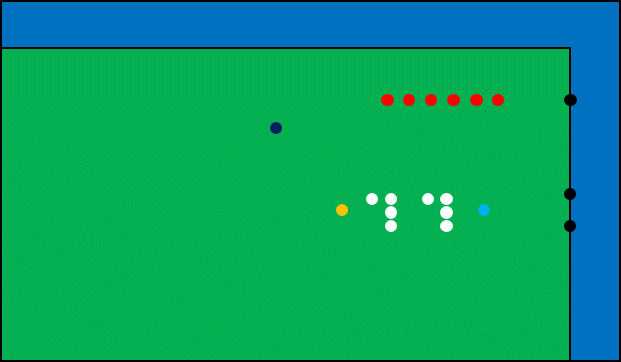
- A player of Blue (1) passes the ball to e.g. player 2 of Orange. This team tries to score over the 23-metre line in a yellow goal.
- Blue interferes with the defending of the Orange and tries to capture the ball and score in the normal goal. When Blue is over the 23-metre line, the team-mate at the side-line is allowed to join the game.
- Blue substitutes with Orange after 2 goals from either team.
Tips Ball possession
- Pass with good speed and direction.
- Be available (outside of the field).
- Use the hard feint pass (flats and push).
Tips Not Ball possession
- Force the player in ball possession to the side.
- Provoke making mistakes.
- Perform a quick counter after conquering ball.
Tips Counter
- Force the player in ball possession to the side.
- Provoke making mistakes.
- Perform a quick counter after conquering ball
Make it easier
- Make the field deeper (towards the center line).
Make it more difficult
- 1 extra player per team.
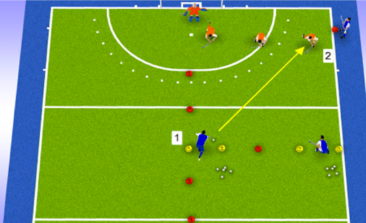
- The trainer (T) rolls the ball (1) to one of the four front players (for example A).
- Player A receiving the ball (2) plays a duel with player V1 opposite him.
- The goal is to score the ball at the opponent's goal.
- If V1 manages to intercept the ball, he plays it to V2.
- Now V2 may try to score with player B.
- After a goal, the form of play starts over again.
Making it easier
- Play a 1-1 duel on the two fields for a few minutes, after a goal, the substitute player comes into play.
Make it more difficult
- After the ball is taken by V1, V1 and V2 may try to score against player A (now it has become a 2-1 game).
- A has to defend.
- If A takes the ball, he plays it to player B.
- Player A and B play a 2-2 duel on players V1 and V2.
- Player 1 asks the ball in front of the pilons and receives the ball from player 3.
- At that moment player 2 grabs a ball and dribbles to the back line.
- Player 1 runs with his/her ball to the circle and finishes there.
- Then player 1 runs to the penaltyspot where he/she receives the ball from player 3.
- The ball is then finished on goal again.
- It works just like a normal game only now there's a square in the middle.
- If a shot or other foul is made, or if the ball has been out of bounds, the trainer throws/plays in a new ball from inside the square.
- The ball does not necessarily go to the same team or at the place where the foul was made.
- The size of the field depends on the number of players.
- Player 1 plays the ball to player 2 after which player 1 runs through
- Player 2 bounces the ball back to Player 1,
- Player 1 aligns the ball between the pilons (The player is not going to run into the "pilon box".)
Player 1 then finishes the ball at goal
You can speed up this exercise by placing the mirrored exercise on the other side, allowing you to play from 2 sides.
Aim:
To become physically as well as technically warm as preparation for the training.
Set up:
The exercise will be done with a maximum of 4 people. Of course you can put a multiple of these so that the exercise still works.
1. The players 1 start with the ball and play it to their players 2. Then they change positions.
2. Players 2 play the ball back to players 1 and also change positions.
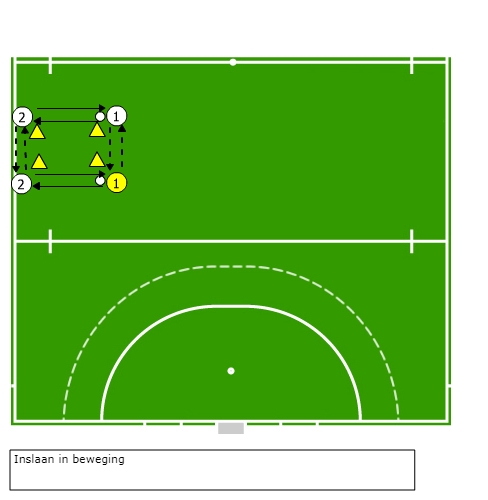
Variations:
- You can vary the way of passing (hitting, push, flats)
- Increase the distance between the pilons that players only has to run further.
- Increase the distance between the pilons that players have to pass over longer distances
- Increase both distances.
- Increase speed.
- Make as many successful passes as possible in time.
Points of attention:
- Sit low for a good control.
- Stick to the ground at ball control.
- Play the ball on the forehand side.
- Stand still while performing a ball control.
- Person 1 dribbles with the ball, does a 3D trick
- and passes a backhand to player 2 while running.
- Player 2 passes the ball to player 3 in the run.
- He dribbles along the obstacles and does a 3D trick at the end,
- Then player 3 hits the goal with a backhand shot.
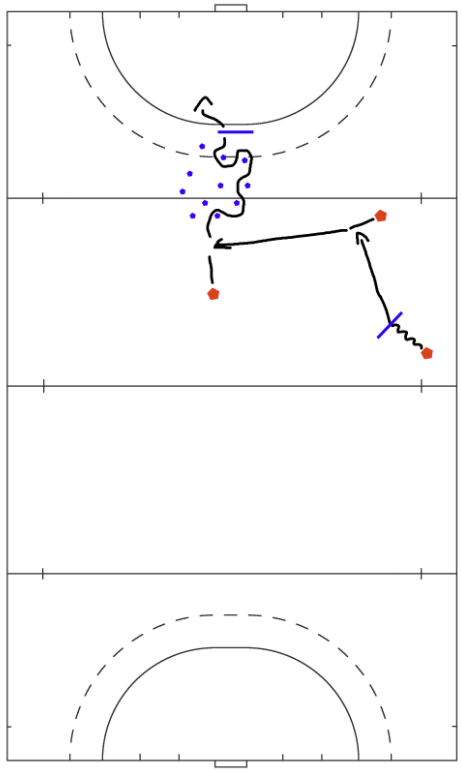
- Balls are at the first pilon.
- The player at the first pilon passes the ball to the second pilon,
- who pushes the ball through the pilons to the third person.
- The third person runs in on the ball and runs even further,
- then he pushes the ball to person 4 while he's running.
- Person 4 runs around the pilons and passes the ball at the top of the circle,
- where person 5 has just run up to finish the ball in the goal.
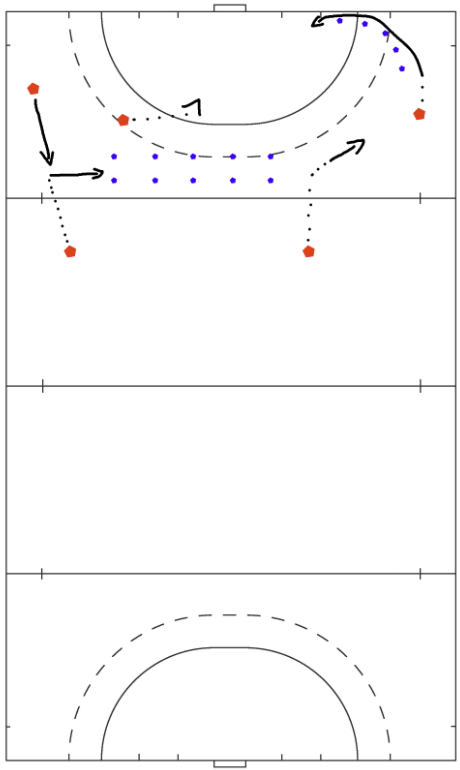
Aim:
Getting warm through a combination of passing, running and controlling the ball while running or standing still.
Set up:
This exercise also known in volleyball. The pilons are not quite in a triangle. It is possible, depending on the number of players, to set up multiples of the exercise.
1. The player at A plays the ball straight on to the player at B.
2. The player at B plays the ball to the player at C and runs towards point A.
3. The player at C receives the ball at point D and passes it to point A.
4. For the substitution A goes to B, B via D to C and C to A.

Variations:
- The stroke can be varied. (hitting, push, flats)
- The distances can be increased or decreased to adjust the level of difficulty.
- Pilons can be placed to play in between. This to increase the accuracy. When you make the pilons smaller, the difficulty increases.
- To play the ball from C to D, it can be bounced.
- To play the ball from D to A, it can be bounced.
- You can also place point C on the other side so that you turn backhand and forehand.
- When you place point C in 90 degrees from point B, you can rotate the same exercise only then from a different angle at point D.
- When you put down different situations, you can let the exercise rotate. Situation A is the standard, with situation B the exercise is mirrored, with situation C the exercise is set up in such a way that point B and C are at 90 degrees from each other and situation D is a mirror of situation C.
Points of attention:
- As a trainer you can take a good look at the different techniques of your players.
- Sit low when controlling the ball
- When playing the ball from C to D, the ball must not pass too far in the direction of A. The aim is for the player coming from B to take the ball at right angles.
- Play where possible on the forehand.
- Stand ready to control the ball. (low to the ground, stick on the ground)







